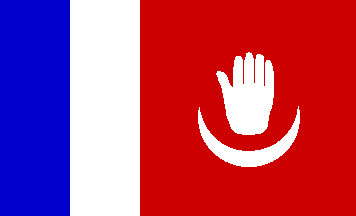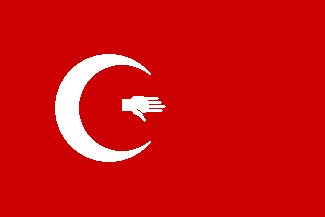
This page is part of © FOTW Flags Of The World website
Anjouan (Comoros)
Nzwani / Mawana
Last modified: 2003-04-05 by antonio martins
Keywords: nzwani | crescent: points up (white) | hand (white) | canting | anjouan | secessionist | law | sultan | mawana | crescent: points to fly (white) |
Links: FOTW homepage |
search |
disclaimer and copyright |
write us |
mirrors
![[Anjouan flag]](../images/k/km-nz.gif)
by Pascal Gross, 10 Apr 1998 |
See also: Other links:
Discription of the flag
Album 2000 [pay00] says:
2. State of Anjouan (Nzwani) [unrecognized]Red flag with white hand and crescent. Somewhat different from the image above in details, but basically the same flag. It is questionable how much details we may ask from this kind of flag anyway.� 2:3

Zeljko Heimer, 24 May 2001
Colors
As for the Anjouan flags, yes, the red has always
been darker than the French red
on the flags I�ve seen (although this may change / have
changed as people try to affirm the French link).
Iain Walker, 14 Feb 2000
Design of the hand and reverse
On Anjouan
web site it seems that the hand is detached
form the crescent. It�s also hard to say if the
thumb is on the left or the right oriented,
because we don�t know which side of the flag is
represented on Anjouan website.
Pascal Gross, 10 Apr 1998
Calvarin [clv02] shows the flag
of Anjouan with the hand directly placed on the crescent.
Ivan Sache, 20 Apr 2002
According to the constitution, the flag is charged
with an open right hand. In any case, logic says
it�s a right hand � it would be fairly unthinkable for
an Islamic country to put a left hand on its flag!
Iain Walker, 10 Feb 1999
No one doubts, for the implyed resons, that the
pictured hand is right, but the question about whether the thumb is
pointing to the top or to the bottom of the flag remains because a right
hand can be depicted both ventrally and dorsally, and if only the contour
is show, as in the anjouani flag, no one can tell the difference.
To put it plainly: Should the thumb be pointing to the hoist or to the fly?
And what about the reverse? Is the hand mirrowed or not?, i.e., are both
sides symmetrical (chiral) or identical?... (By the way, this being an islamic
flag, the obverse is considered with the hoist at the viewer�s right hand.)
Please note that none would necessarily be a left hand, since the
first alternative presents the same design to the viewer on both sides of
the flag, and the second shows the same hand, viewed ventrally in the
reverse and dorsally in the obverse...
Ant�nio Martins, 13 Aug 1999
I have a photo picked
from the web showing the thumb pointing to the fly.
Mark Sensen, 14 Aug 1999
I note that the crescent and hand seem to be placed nearer
to the bottom. Should it be so? Or is this a home made flag?
(Are any anjouani flags not hand made, by the way?...)
Ant�nio Martins, 15 Aug 1999
Symbology of the hand
Why does the flag features a hand above an Islamic crescent? Surely images of
the human form are banned in Islam and therefore what is it doing on an Islamic
flag?
Oliver J. S., 02 Jul 2001
Both Muslims and Jews are
prohibited from depicting the human form; but even the strictest
of both religions seem to make an
exception for the hands.
Al Kirsch, 03 Jul 2001
"Anjouan" comes from Swahili "Nzwani", meaning "the Hand"
� thus probably explaining the flag.
Ivan Sache, 20 Apr 2002
Political-historical background
According to a report, the separatist movement in Anjouan adopted the
name Mawana, after a sultan that once ruled
the island. A short note in The Indian Ocean Newsletter (764
10.05.1997: p. 4) said that �elements of Mwawana sawed down the flagpole
flying the national flag and hauled up the white [?] emblem of the late
sultan�.
Jan Oskar Engene, Jun 1997
As far as I know the Mawana flag (the last
sultan�s flag) is the same as the one in the constitution.
The �hijacking� of the Mawana flag by the pro-French movement hasn�t met with
everyone�s approval.
Iain Walker, 14 Feb 2000
The flag used by the Anjouani separatists was the personal standard of
the last Sultan, Omar. This information was
communicated in 1980 to L. Philippe [phi02]
by Said Ali Kemal, the Comorian Ambassador in France, who was the nephew of
the Sultan of Anjouan and one of the sons of the Sultan of Grande Comore.
Ivan Sache, 18 Jul 2002
Since March 1997, separatist islanders of Anjouan and the Comoros government have been clashing over the status of the island. There have been reports of demonstrations, flag hoisting (and hauling), violent clashes, deaths and arrests. The flags hoisted are the "flag of a 19th-century sultanate" and the flag of France.
Reports state that the president of the Comoros promised in a television speech on Friday 1 August that Anjouan would be granted more autonomy. This was to be done by dividing the island into communes. As we have heard, however, the latest development is that a separatist president and a 13 member government has been appointed for Anjouan. On Sunday, the secessionist leader and newly appointed president Foundi Abdallah Ibrahim said: �Our demand is for separation, nothing less.� Nevertheless, Reuters reported that the demand was for separation from the Comoros and return to French rule. This would explain why they fly the tricolour. In fact, according to the Reunion newspaper Le Journal de l�Ile, participants at Sunday�s independence meeting (estimated at some 7000 people), had a picture of Jaques Chirac with the slogan �La France pour tous�. The newspaper quoted a representative of the Anjouan government as saying there was two options for Anjouan: Reunification with France or independence in association with France. French officials rejected this. A second report in Le Journal de l�Ile referred to the new state as l��tat d�Anjouan.
The local flag is now described as red by NANDO Times (report of 6 August, based on AFP wire): �In Anjouan, where the separatists named a �government� Tuesday, the red flag of the last sultan on that island is flying above mosques and on flagpoles alongside the French tricolour.� An earlier report by Reuters also described the flag as red. The Reunion newspaper carried several pictures of the French flag hoisted in various places on Anjouan, but it had no picture of the local flag.
Sources:
- �Separatists on Comoran island Moheli follow lead of Anjouan�, NANDO Times, Global Briefs, 6 August 1997
- �Barrages et drapeaux fran�ais � Moheli�, Le Journal de L��le, 6 August 1997
- Mohamed Kamaradine: �Comoros secessionists elect leader as "president� Reuters 10:50 a.m. 5 August 1997 Eastern
- �Anjouan d�clare son ind�pendance�, Le Journal de L��le, 4 August 1997
- �Comoros islanders demonstrate for secession�, Reuters, 07:56 a.m. 3 August 1997 Eastern
- Mohamed Kemardine: "Comoros President grants islands more autonomy" Reuters 08:18 a.m. 2 August 1997 Eastern
Official flag law
Recent changes
We have one newly adopted offical flag, the old
white hand and crescent on a red field. According to Article 2 of the
Loi fondamentale de L��le autonome de Ndzuani, �L'�le Autonome
d'Anjouan dispose de ses propres symboles qui cohabitent avec les symboles de
l�Union des Comores. L'embl�me de l��le Autonome d'Anjouan est le drapeau rouge
frapp� au centre d�une main droite ouverte au dessus d'un croissant de couleur
blanche.�
See: http://www.comores-online.com/mwezinet/politique/constitutionanjouan.htm.
Jan Oskar Engene, 30 Mar 2002
The separatist, unrecognized flag (1997-2000)
![[Anjouan flag]](../images/k/km-nz.gif)
by Pascal Gross, 10 Apr 1998 |
Here is the article of the constitution of Anjouan concerning the flag (found on the web site http://www.anjouan.org):
In English: (my translation)CONSTITUTION DE L�ETAT D�ANJOUAN
approuv�e par les Anjouanais au cours du r�f�rendum du 25 f�vrier 1998.TITRE 1: DES DISPOSITIONS GENERALES
Art. 3: L�embl�me national est un drapeau rouge frapp� au centre d�une main droite ouverte au-dessus d�un croissant de couleur blanche.
Remark: is it a coincidence that this article speaks about �the national emblem� like in the French constitution? It seems then that there is just a flag and no coat of arms.CONSTITUTION OF THE STATE OF ANJOUAN
approved by the Anjouanais [inhabitants of Anjouan] by referendum on the 25th February 1998.TITLE 1 : GENERAL DISPOSITIONS
Article 3: The national emblem is a red flag charged in the center with an open right hand above a white crescent.
Pascal Vagnat, 16 Mar 1998
It is the same flag as the old sultan flag
and as the post-2002 island flag within the Comorian Union.
Ant�nio Martins, 01 Apr 2001
Other flags in Anjouan
At http://www.anjouan.org,
you can see the flag of Anjouan in the opening
page, and in the page �phototheque�, there
are several photos with flags. Interestingly enough,
we can find more often the French flag then the
Anjouani, and in two pictures, we can see both flags
side by side.
Jorge Candeias, 19 Jan 1998
As to the frequencies of the flags, I think that
it was French flag,
this flag and
Mawana flag, in that order, probably
because the French flag is easier to come by! I didn�t
see the Mawana flag much.
Not much policy in evidence, although interesting as an anecdote: I
arrived in Anjouan by boat from Mayotte. In Mayotte the boat (an
Anjouan boat) flew the Comorien flag (the official one, green and
white), as its flag of origin. Halfway over to Anjouan the Comorien
flag came down and the boat sailed into Mutsamudu under the French flag
(Anjouan being �French�, of course).
Iain Walker, 05 Apr 1999
Franch-anjouani mixed flag

by Ant�nio Martins, 10 Feb 2000
Among the flags I saw on Anjouan in April 1998
included one that was a mixture of the
French and
Mawana flags: basically the blue,
white, red of the
French flag, but with the red part slightly stretched
and incorporating the white hand and crescent
[see photo].
This flag was photographed at the post office in
Domoni, but I also saw it in Mutsamudu. I�ll try and
find out if it�s still being used.
As for this flag and the French one, it wasn�t always
easy to tell the difference � as I said, it was a while
before I even became aware there were two different
flags. But I also saw this one flying from a government
building in Mutsamudu, Public Works, I think.
Iain Walker, 10 Feb 1999,
02 Apr 1999 and 05 Apr 1999
The flag on this photo looks like a �tinkering�
of a french and anjouan flag sewed together to show
the aspiration of Anjouanese people to return under
french administration.
Pascal Gross, 01 Apr 1999
The hand sure looks black at first glance, but it
isn�t: it�s white: This
picture was taken
with the light source from behind, which is quite
evident if you lighten it up. The hand and crescent
where either made of a patch and sewn over the red
field, or printed using a thick dye (or whatever).
Therefore, the light from behind doesn�t cross the
symbol as it crosses the flag itself. Furthermore,
the upper folding of the fly further obscures the
symbol area, making it look very dark. If you lighten
the whole thing up, however, you�ll see it appear
white by miracle.
Jorge Candeias, 02 Apr 1999
Variation of the flag

by Jean-Francois Blanc, 12 Aug 1997